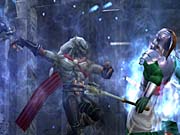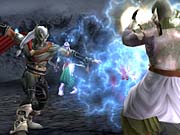Legacy of Kain: Defiance Designer Diary # 3
Game designer Kyle Mannerberg talks about the evolution of Kain in our latest diary.
By Kyle Mannerberg
Game Designer
Back in 1996, Crystal Dynamics produced the progenitor of the Legacy of Kain series. Blood Omen: Legacy of Kain was originally developed for the PlayStation game console and centered on the exploits of the fledgling antihero Kain in his quest for revenge against the forces that stole his mortal life.
Among the large cast of characters who populate the world of Nosgoth, Kain has remained constant as the most important character in the series. He made many appearances in the Soul Reaver series as one of Raziel's main antagonists and continued to further explore his own unique destiny in Blood Omen 2. What it is that has kept Kain so vitally important to the series, and where did his journey start?

To quote Amy Hennig:
"In the centuries before Kain's birth, the land was protected by an oligarchy of sorcerers known as the Circle of Nine. These guardians were sworn to serve and protect the Pillars of Nosgoth, the ancient edifice towering over the earth as a manifestation of the mysterious power which preserved and gave life to the land.
The Circle was infiltrated by an enemy and Ariel, the Balance Guardian, was cruelly murdered. Her assassination sent psychic shock waves throughout the Circle, and in their derangement, the remaining sorcerers turned their powers to dark purposes, abandoning the Pillars to stand like silent, decaying sentries.
Into this dying world, Kain was born. The son of an aristocratic Nosgoth family, he lived the privileged life of a nobleman, never realizing his undiscovered destiny--that he was marked from birth as Ariel's successor and was fated to take her place as the Guardian of Balance. Ignorant of his destiny, the ambitious but directionless young nobleman was ambushed by brigands and murdered, cruelly impaled on his assassin's sword.
Plucked from the brink of oblivion by the necromancer Mortanius (the Guardian of Death), Kain awakened in the underworld, still transfixed by his enemy's blade. Tormented by his hunger for vengeance, and heedless of the spiritual cost, Kain recklessly accepted the necromancer's Faustian offer for revenge, and rose from his tomb to discover that he had been resurrected as a vampire.

Kain quickly tracked down his assassins and exacted his bloody revenge. With his vengeance and hunger sated, he sought only a cure for the vampiric curse that afflicted him. Guided by Mortanius and the specter of Ariel, Kain hunted down each of the corrupt sorcerers now poisoning Nosgoth. Only with their deaths could the Pillars be healed. Kain believed that restoring this balance would release him from his curse.
As his quest brought him full circle, Kain confronted the destiny that Mortanius and Ariel had hidden from him--the fact that he was the next Balance Guardian and only by sacrificing himself could he restore the Pillars. Ariel presented Kain with a final climactic decision. Kain could either sacrifice himself to heal the land, and ensure the extinction of the vampires, or he could refuse the sacrifice, and seal the world's corruption.
Revolted by the machinations of the human sorcerers, and alienated from his former humanity, Kain chose the latter path--opting to rule the world in its damnation rather than commit himself to oblivion. This apocalyptic act completed the Pillar's destruction, and the mighty columns toppled as Kain sealed their ruinous fate.
The Pillars, Kain ultimately realized, were more than just a human edifice. The health of the Pillars was tied inextricably to the health of the land. With the Pillars left unrestored, corruption seeped slowly into the land like poison, turning his empire into an irredeemable wasteland."
Kain has always been such a powerfully compelling character, not only because of the depth of his story but also for his inherently archetypal nature. People familiar with classical mythology might recognize Kain as an Oedipus figure. Not in the motherly sense, but in that he struggles against the shackles of a dark fate that was predetermined long before his birth. Though the unseen hands of gods and demons manipulate his path along this destiny, he refuses to surrender to it.

Kain also has strong symbolic ties to the "maimed king" of Arthurian legends (perhaps more well known as the legends surrounding Parsifal and the "Fisher King"). Like the king of legend, Kain is inextricably entwined with the state and condition of his empire. As long as he remains corrupted as a Guardian, the Pillars cannot be restored, and, therefore, Nosgoth will remain blighted and poisoned. Only by healing his own corruption will Nosgoth be saved from its similarly linked fate.
Lastly, Kain (like Neo of The Matrix or John Murdoch of Dark City) can also be considered a gnostic hero, as he struggles in a world veiled in lies and illusion that is dominated by a tyrannical deity (the "Demiurge," or Elder God). It is this deity who reigns secretly over Nosgoth's corrupt world, engineering it to imprison and manipulate the souls of humankind. Of course, what also makes Kain an imposing and memorable character is his weapon, the Reaver, and the power with which he wields it. This time around, Raziel continues to align his Soul Reaver with elemental affinities (water, fire, and other traditional elements) to gain new power. However, in Defiance, Kain gains different abilities for his Reaver in the form of spells earned by completing a vampire relic destined for the Balance Guardian. In homage to Blood Omen 1, some of these spell abilities have been salvaged and updated into 3D from the original game--a move that will hopefully appeal to the hardcore Legacy of Kain fans.
Heightening the difference between the two characters from the start, Raziel starts with a lower level of telekinetic skill than Kain. His skills at the beginning of Legacy of Kain: Defiance are limited to merely sending out bolts of kinetic force. Kain, on the other hand, has had hundreds of years to master his telekinetic abilities and starts the game off with a much higher level of mastery. Immediately, Kain is able to use his telekinetic abilities to drain the blood of his critically wounded victims remotely (as in Blood Omen 1 and 2). Kain is also able to use his TK abilities to grab nearby objects and break them or throw them against his foes. He is even able to snag opponents off the ground or from the air and throw them into their allies, into nearby fires, off cliffs, through spikes, and more. Kain can even pull enemies back into sword range, thereby extending the player's string of attacks.

Additionally, both Kain and Raziel share the ability to gain experience from executing their starting combat techniques. As players reach new experience levels, they can unlock new combat moves, all of which can be seamlessly strung together to form the crux of Defiance's intuitive linking combo system. These linking attacks, used in conjunction with Kain's heightened telekinesis, should create a lot of very unique play strategies and attack combinations from player to player. For example, imagine pulling an enemy from across the room instantly into range of your attacks or finishing a deadly combo that sends your enemy flying backward or up into the air only to finish the combo by telekinetically blasting him onto a roaring fireplace.
We have put a lot of effort and time into refining all the things that make Kain the eye-catching and attention-captivating antihero he has evolved into over the years. Whether attracted by the sinuous story or the visceral combat, we think that both action gamers and the people who enjoy our deep story will enjoy Defiance, and we hope that you all are as happy playing Defiance as we have been developing it.
Got a news tip or want to contact us directly? Email news@gamespot.com
Join the conversation